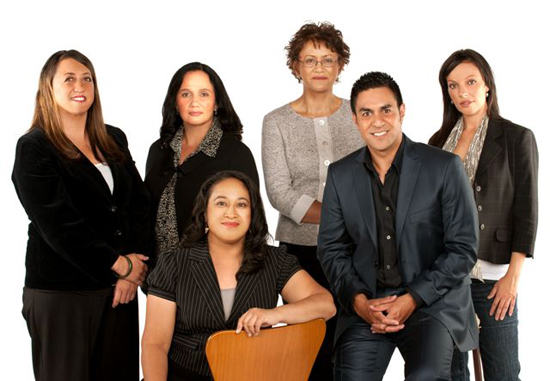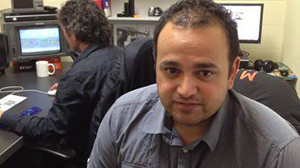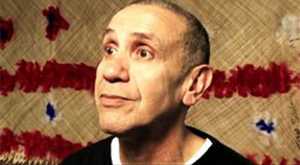
Media coverage of Pacific issues is often criticised but Polynesian journalists and New Zealand media are making an effort to improve visibility of Pacific culture. Jamie Small reports on the progress.
There is a small group of reporters in New Zealand dedicated to covering Pacific issues. Most of them are from a Pacific Island background, and are passionate about their own culture.
These journalists say Pacific coverage is getting better in New Zealand media, but there is still room for improvement.
Pacific issues see a lot of coverage in alternative media, but are harder to come by in the mainstream.
Walter Zweifel, news editor for Radio New Zealand International (RNZI), is surprised when he watches mainstream media.
“If I’m Joe Bloggs turning on the TV, my point of view is that it’s a sub-standard coverage of Pacific affairs.”
Zweifel is similarly critical of print media.
“Newspapers can ignore bread-and-butter issues going on in our own [Pacific] neighbourhood quite happily.”
Noumea strikes
He says New Caledonia, a territory only 2000km away from New Zealand, has been experiencing national strikes that seriously affect the country, and NZ media will not cover it.
“Last Saturday, New Caledonia had run out of petrol. It’s not mentioned anywhere here!”
Similarly, the controversial election in French Polynesia last month has gone largely unnoticed here.
“Two to three weeks ago I was in Tahiti for the territorial elections. I don’t think there was any mention in New Zealand domestic media. And the developments were massive.”
“Surely they could find room for 20 paragraphs the day after an election to say, ‘This is the result’,” says Zweifel.
He says New Zealand’s inconsistent coverage of the Pacific leads to a lack of understanding of the region.
Fiji, for example, is considered only in its merits as a holiday destination, despite the fact the country is in constant political strife.
‘Getting cold’
“We think, ‘It’s getting cold. Fiji would be a nice place to go because it’s warm,’” he says.
Zweifel says an obsession with crime in New Zealand media takes up space that could otherwise be used to cover important issues in nearby countries.
He says New Zealand is not a very criminal society. And yet even with the low crime rate, a lot of bulletin time is given to relatively inconsequential crime-related news.
Zweifel says his opinion is that New Zealand media is too fixated with the happenings in the United Kingdom, United States and other “far-away countries”.
“A European paper wouldn’t ignore an election in a neighbouring country. Coverage here is extremely lacking and inconsistent.”
He says foreign celebrities are often passed off as world news in New Zealand.
No coverage
“There are significant developments in Fiji and no coverage,” he says.
“But if a Pommy princeling goes to the Solomons, that is news.”
 Adrian Stevanon, of Māori Television’s Native Affairs, says everyone can be encouraged to do better when it comes to Pacific media. He says Pacific news should not be aimed just at Pacific people, but all New Zealanders.
Adrian Stevanon, of Māori Television’s Native Affairs, says everyone can be encouraged to do better when it comes to Pacific media. He says Pacific news should not be aimed just at Pacific people, but all New Zealanders.
He also says Pacific stories should preferably be covered by Pacific people.
“It’s always difficult for non-Islanders to get a perspective on island stories,” says Stevanon.
“Some reporters make it their round and do a really good job. Some just fly in to a disaster area to report, and I think ‘Oh, that’s not right’.”
Taualeo’o Stephen Stehlin, of Tagata Pasifika, says Pacific Islanders are often portrayed negatively in the mainstream media.
Voyeuristic shows
He says many shows are voyeuristic and play negatively on cultural issues for entertainment,
Stehlin says shows like Border Patrol are culturally insensitive.
“Years ago, Pacific and Māori people were hounded and raided and asked in the streets for their passports,” he says.
“Now we put a camera crew on the shoulder of dawn raids. And you know what it is? Brown people chasing Asian people.”
Taualeo’o also says New Zealand media should make more effort to create programmes in Pacific languages.
He says cost is a barrier to creating language-specific programmes.
‘Just do it’
“But that shouldn’t be a barrier. We should just suck it up and do it.”
3 News reporter Sanele Chadwick says New Zealand often covers Pacific issues only from a “palagi” perspective.
“The media tries to talk to Māori and Pacific islanders from a European point of view,” he says.
He uses the example of a palagi television reporter who reported a story in Samoa after a natural disaster.
“[The reporter] said something like: ‘Look at these houses, it’s really bad, all the walls are gone,’” says Chadwick.
Traditional Samoan houses, or “fales” are often built without walls.
He says mainstream media often misunderstands cultural traditions, such as the practice of Islanders in New Zealand sending money home to the islands.
Sensationalist story
“The story sounds sensationalist, but to me it’s kind of standard,” he says.
Chadwick says misunderstandings in the mainstream media lead to xenophobia.
Radio New Zealand International covers current affairs in seven different languages, and broadcasts across the Pacific via short wave radio. RNZI programmes can also all be streamed off the internet.
Last year, domestic Radio New Zealand National appointed a full-time Pacific issues correspondent, Karen Mangnall.
TVNZ, Fairfax Media New Zealand and the New Zealand Herald also have their own Pacific correspondents.
Tagata Pasifika is a long-standing current affairs programme running on TV1, targeted at the Pacific Island audience. TVNZ also runs a Pacific youth show called Fresh.
Native Affairs on Māori TV frequently covers Pacific issues.
Specialist media
TV3’s website has a page called Pacific Profile, dedicated to covering Pacific news.
There is specialist media in New Zealand that caters to the Pacific population, such as Spasifik magazine, and Radio 531pi.
Vaimoana Tapaleao, Pacific correspondent for the New Zealand Herald, says there is plenty of alternative media that covers Pacific issues, but there are barriers to communication with mainstream media.
“Personally I think a main reason mainstream media don’t cover Pacific issues is it doesn’t matter to them. It isn’t a high priority,” she says.
However, she says the Pacific community often don’t like to make their news known to mainstream media.
Tapaleao says many islanders living in New Zealand will happily talk to Pacific island newspapers such as the Samoa Observer or Matangi Tonga, but will not contact the New Zealand Herald.
“They think they’ll end up on page 57. Which is sometimes the case,” she says.
Tapaleao says there are plenty of Pacific events happening in places like museums and libraries, but mainstream media does not usually hear about them.
Media mistrust
“The Pacific community needs to step up and send press releases out to mainstream media,” she says.
Adrian Stevanon says islanders mistrust mainstream media because of negative stereotypes that are often portrayed.
“That’s obvious, it’s easy to pick up crime stories,” he says.
Sanele Chadwick says the biggest challenge is trying to get support.
TV3 gave Chadwick and his colleague Arthur Rasmussen the go-ahead to develop Pacific Profile, and the online team has given a lot of help. However, most of the ongoing work on the page is done by Chadwick and Rasmussen voluntarily in their spare time at Rasmussen’s home.
 Taualeo’o Stephen Stehlin says small, and often conservative, Pacific communities can make it difficult to speak up in the media on controversial issues such as gay marriage and prostitution.
Taualeo’o Stephen Stehlin says small, and often conservative, Pacific communities can make it difficult to speak up in the media on controversial issues such as gay marriage and prostitution.
‘Scared to talk’
“People are too scared in a small community to say what they think.”
Adrian Stevanon says: “I would go as far as to say it’s getting better.”
“The way to change it and to get more stories out there is to get more Islanders in the newsroom.”
He says young Islanders are more interested in the rugby field than the media.
Stevanon says that as the brown population of New Zealand is growing, communities, universities and newsrooms need to be providing support for young Islanders in the media.
However, he says Pacific Islanders don’t tend to come into the media through journalism school, so they need more encouragement at a high school and community level.
Tagata Pasifika reporter Sandra Kailahi says a lot of young Pacific islanders are interested in media, but not specifically in journalism.
Not lucrative
“It’s not seen as a lucrative career or something their parents would understand.”
She says getting more Pacific Islanders involved in journalism would educate newsrooms and the public.
“In terms of educating mainstream New Zealand about Pacific island issues, we don’t just want to reinforce stereotypes. We need some positive stories.”
She says at the moment the mainstream tends to focus primarily on crime, health and socio-economic issues that affect Pacific Islanders.
“If you live in the south and don’t know any Pacific people, that’s all you’ll ever think of them,” she says.
Taualeo’o Stephen Stehlin says the media needs to be a part of New Zealand’s cultural identity.
“Who are we as New Zealanders? We are people from the South Pacific. Even people from an Anglo-Saxon background have been here for many generations.”
Reflecting identity
He says journalism doesn’t yet reflect this identity.
“You see [Pacific culture] more in art, and in a down-and-dirty way in mainstream media.”
He also says New Zealand should take a leadership role in setting up the media in the Pacific.
This way, Pacific news could be told from a Pacific perspective rather than a white New Zealand perspective.
“For say $200,000 per country, and I’m talking about countries like Niue, Samoa, Tonga and the Cook Islands, we could put in a television uplink. Give them training and maintenance, and they could send us stories,” says Stehlin.
“At the moment we have to helicopter teams in.”
“I’d willingly bury [Tagata Pasifika] if we could have a decent Pacific news service,” he says.
Active coverage
Taualeo’o says the media need to actively cover French Polynesian and Melanesian issues.
“French Polynesia is right next door. It’s our part of the world,” he says.
“But in the media it’s invisible.”
Walter Zweifel says West Papua is probably the bloodiest place in the Pacific since World War 2.
“But there’s no reporting here. Nothing in the Herald. Nothing in the Dom Post,” he says.
Sanele Chadwick says there needs to be an effort to push Pacific stories from alternative media on to prime time.
“Personally, I’d love to see those stories from fringe shows on mainstream. It’s good to have these stories, but you’re only showing a few people. The mainstream audience is not seeing Pacific stories,” he says.
Older perspective
Chadwick says Pacific stories in television, radio and newspapers are being told from a perspective of white, middle aged people, instead of the growing brown population.
According to the last census in 2006, 6.9 percent of New Zealand’s population identified as Pacific Islanders. That number is assumed to have grown in the last seven years.
“The day you have the majority of New Zealanders understand other cultures is the day you have done your job,” says Chadwick.
Though they agreed it needs improvement, most of the journalists interviewed were happy with the state of Pacific media in New Zealand.
Zwiefel says if you are looking for Pacific news, alternative media is covering it well.
“The internet has changed everything,” he says.
“The information is there for people who are interested.”
Dateline skipped
Tapaleao says some Pacific stories are being picked up by the mainstream. She refers to a story done in 2011, when Samoa changed to the other side of the international dateline and skipped a day.
“That was on the front page, and TV picked it up as well,” she says.
Stevanon says there are a lot of islanders writing in Pacific media, and TVNZ in particular has had access to a number of Pacific island journalists.
New Zealand On Air has a document that outlines a strategy for managing funding in Pacific content.
This is an extract from the introduction of the NZ On Air Pacific Content Strategy 2012:
“As part of our ongoing programme of performance improvement actions, NZ On Air is evaluating the provision of content for Pacific audiences in New Zealand. These audiences comprise members of many ethnicities originating from the Pacific Islands.”
Chadwick says TV3 gives him complete freedom in the Pacific stories he wants to cover for Pacific Profiles.
Investigative journalism
He is also very complimentary of investigative journalism being done in the Pacific by other New Zealand programmes.
“Adrian [Stevanon] is really into getting to know the people he is reporting on for those longer-form stories,” he says.
Taualeo’o is also complimentary of the efforts New Zealand media is making to improve Pacific coverage.
“Mainstream media is really trying hard,” he says.
He says the fact that Pacific countries are shown in news weather reports is a great development.
“It’s not news, it’s information. But it shows where we are in the world,” he says.
Taualeo’o says good Pacific stories do get picked up by the news services.
“And when it turns mainstream it’s a delight.”
He says the media is important to maintaining cultural identity, especially in the Pacific.
“The Pacific is little and fragile. We’d better treasure and keep our Pacific-ness, our Polynesia together. If we don’t, nobody else will.”


